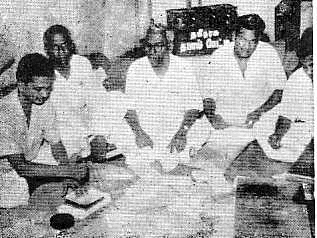"No More Tears, Sister"
A Film Review
by Dr. Rajan Sriskandarajah
|
It is quite evident that the two sisters, one more than the other, didn’t think this matter through well enough. An armed rebellion against a government is not like an Arnold Schwarzenegger movie: A Lot of Violence, But No Blood! Obviously, they didn’t know this then. If they had expected an armed rebellion against Sinhala tyranny and see no blood, they were obviously mistaken. I don’t quite blame them for this – they were young, idealistic, and obviously very naïve.
|
I finally got to watch the feature film “No More Tears, Sister” on PBS, more than a year after it was first aired in Toronto. I was there then, but due to time constraints I couldn’t see it. However, at that time I heard some negative comments from those who saw it. Now that I have seen it myself, I must say that I have a different take on this movie. It is a beautiful, and yet a very sad, story about two idealistic and courageous sisters, and I must say I admire them.
The film moved me to write this review primarily because I, too, come from a background similar to theirs, and as a teenager I too was idealistic as they were. As I reminisce about my own teen-years in Sri Lanka, of a near fifty-year vintage now, I can identify with them completely. We were Tamils in a predominantly Sinhala country that oppressed us in countless many ways, and continues to do so, primarily because we are Tamils. I am a bit older than the two sisters (by a decade or so), but the bigotry we faced as Tamils in Sri Lanka was similar.
Although Rajani and I both ended up as medical doctors, I give credit to Rajani’s achievement more, because the hurdles for her as an aspiring medical student were greater than mine. I entered medical school several years before her. In my time ‘merit’ was the only criterion for admission; whereas when Rajani tried and succeeded, the barriers for the Tamil students were harder, with convoluted schemes to favor Sinhala candidates. Rajani must have performed a lot better than I did at the entrance exam.
Nirmala, the surviving sister, tells the story of her beloved sister Rajani, who was obviously a smart and courageous woman. In fact, they were both courageous in different ways. To start with, they both broke the mold of the middle-class Jaffna Tamil society. Children there (especially girls) were expected to stay clear of politics, or for that matter anything controversial, and most did. Participation in ‘politics’, in particular, was a taboo. I vividly remember being scolded by my mother, even as a 16-year old boy, for having attended a late-night political rally in Jaffna in 1960. Despite this scolding I did join the 1961 Satyagraha.

V. Navaratnam (in spectacles) and colleagues volunteering as Eelam postal workers during 1961 satyagraha. Source: Federal Party Silver Jubilee Souvenir (1974)
|
My participation in the ‘non-violent’ Satyagraha was, however, the extent of my own ‘rebellion’ as a teenager. I now wonder as to what I would have done if I had been presented with the choices Nirmala and Rajani faced a decade later. The documentary ‘No More Tears, Sister’ walks us through the options they had.
Nirmala’s generation was presented with the option of only an ‘armed’ rebellion (or do nothing), unlike mine which was entirely ‘non-violent’. Nirmala joined this ‘armed’ rebellion (LTTE), and sought the help of her doctor sister’s help for the injured rebels. Of the two sisters, the reluctant one ended up being dead. What a burden of guilt Nirmala must carry to this day.
What would I have done in the shoes of the two sisters, is something that I still agonize over. My choice, even though it cost me three-years in my career-path, was far simpler. Joining a non-violent movement was a cake-walk compared to joining an armed insurrection. By the time the two sisters came of age, the days of non-violent protests (Satyagraha), having failed to win Tamil rights, were over. An armed rebellion was taking root, and their choices were very different to mine.
Before I get to the point about the two sisters joining an armed rebellion, I need to say one thing about the attitude of my own generation of youths. Many of my schoolmates at that time, of the middle-class Jaffna Tamil variety, didn’t join me in this ‘non-violent’ political movement. Their parents forbade them, and my ‘friends’ simply complied. In this context, I find two middle-class-Jaffna-Tamil-girls joining an armed rebellion most fascinating, and in my view, most admirable.
But then, they were no ordinary girls. They rebelled against every tradition of the Jaffna Tamil middle-class society of their time. They both found their own life-mates, in a society where parents found husbands for their daughters. Nirmala found hers in a university professor (who was ‘happily’ for her parents, a Tamil). Rajani on the other hand went further, crossed ethnic lines, and married a Sinhalese, an idealistic Sinhala boy, who himself was a rebel. How much more dramatic can this story get?
 Nirmala Rajasingam as a university student Nirmala Rajasingam as a university student |
In the movie, Nirmala tells the story of the agonies and the ecstasies of their escapades well. Caught and imprisoned by the government of Sri Lanka, Nirmala talks about her own incarceration in solitary-confinement in a ghastly Sri Lankan prison (where Tamil political prisoners had been summarily executed before), and a dramatic jail-break to escape to India, helped by the LTTE. Jail-break and a clandestine escape by a night-boat to India, by a Jaffna-Tamil-middle-class-girl – this story is incredible!
Later, in the nineties, Rajani too leaves the country to go to England. She had been in England before, but even after her second trip abroad, she returns. After she left Jaffna for the second time, her belongings were ransacked by the soldiers of the Indian Peace Keeping Force (IPKF), who were reportedly infuriated by her record-keeping of the human rights violations by all parties, including the Indian army.
Rajani returns to Jaffna with full knowledge of the fact that she was hated by all actors. She returned, according to Nirmala, because the medical students there needed her help. It was a troublesome period, because ‘human rights’ was at its lowest ebb then, as it has been in 2006. Rajani believed that she was up to the task, but obviously she was mistaken.
Rajani’s efforts to document human rights violations in Jaffna had angered a lot of people, any one of whom could have wanted her dead. But, in the movie Nirmala asserts that Rajani was killed by the LTTE. This is by no means certain. At that time, no less a person than the Catholic Bishop of Jaffna, in an interview with a British journalist, had alluded to the Indian army involvement in the killing. I find Nirmala’s categorical accusation unreliable, considering the fact she was (self-admittedly) publicly estranged from the LTTE on ideological matters. Nirmala’s criticism of the LTTE in the film on other unrelated matters, such as the child-soldier issue, I must say, diminishes her credibility further.
The issues of ideology and methods in a war takes us to another plane. ‘All is fair in love and war’ is not just a cliché; it is a fact of life. All through human history and up to now, the use of violence to further political-aims has been the norm – ‘terrorism’, as it is now called. The world history is choke-full of examples. Regardless of what the Americans, the Europeans, the Japanese and the Australians want to tell us now on how to behave, their own histories belie what they now wish to condemn.
Be that is it may; let us just look at Sri Lanka. What does one do with a state that unremittingly and unrepentantly (to this day) oppresses a nation of people living in its territory? A thirty-year ‘non-violent’ rebellion had already failed by the time the youths of Rajani's and Nirmala's generation decided on an armed rebellion.
An armed rebellion has its own sets of rules, which the two sisters obviously didn’t consider. Before I reflect on any kind of judgment on this matter, I must admit that I, too, would have had a difficult time with this. While I admire, to the point of veneration, the tens of thousands of young Tamil men and women who joined, I am not sure if I could have done it myself. Would I have considered taking up arms, or even a jail-break? Would I have gone back to Sri Lanka from the safety of London, after my residence was ransacked by a visibly irritated armed-force of whatever persuasion?
It is quite evident that the two sisters, one more than the other, didn’t think this matter through well enough. An armed rebellion against a government is not like an Arnold Schwarzenegger movie: A Lot of Violence, But No Blood! Obviously, they didn’t know this then. If they had expected an armed rebellion against Sinhala tyranny and see no blood, they were obviously mistaken. I don’t quite blame them for this – they were young, idealistic, and obviously very naïve.
Nirmala left the movement when it got too hot for her comfort level, and this is totally understandable. Hundreds of others have done the same, safely and without retribution. I have met quite a few young Tamils who claim to have been LTTE fighters, and had left the ‘movement’ without reprisals, but nevertheless have remained loyal to the ‘movement’. But Nirmala claims that this is not the case for those who want to leave the LTTE.
Nirmala carries a burden of guilt – she introduced her sister to an armed rebellion, herself not comprehending the consequences fully, and now her sister is dead. As to who fired the bullet, it is still uncertain, but she needs to blame someone for her loss.
Men and women who act with courage, for their beliefs and convictions, deserve a special place in human history. The sisters, Nirmala and Rajani, were two daughters of Thamileelam who rebelled with admirable courage and sacrificed a lot. Thamileelam is blessed with tens of thousands like them, and, as Tamils we should be proud of them all. Rajani and Nirmala, even with Nirmala’s regrets in the movie, deserve a special place in our collective memories.
|
 Home
Home Archives
Archives Home
Home Archives
Archives